European Badger Senses
There’s a distinct paucity of information on the way in which badgers experience the world, with virtually no studies having been conducted to empirically assess their eyesight, smell, hearing, or brain function.
In their 1996 tome, Badgers, Ernest Neal and Chris Cheeseman note that badgers have well-developed brains with highly convoluted dorsal surfaces to their cerebral hemispheres, although they don’t cite a source for this. Neal and Cheeseman also mention that the olfactory lobes in the brain, those associated with processing odours, are comparatively large, suggesting that badgers have a good sense of smell. By contrast, the corpora quadrigemina, areas of the brain responsible for processing visual and audio signals, are small and appear swamped by the cerebral hemispheres, implying that vision and hearing are probably less acute. Overall, Tim Roper summed up the current state of research well at the start of his chapter on “Special Senses” in Badger when he wrote:
“Naturalists universally agree that badgers have an acute sense of smell, pretty good hearing and rather poor vision. However, this view is based almost entirely on anecdotal evidence: very few experiments have been conducted to investigate the nature and limits of the badger’s sensory world, and hardly anything has been written about the structure of the sense organs themselves or about the parts of the brain that serve a sensory function.”
Vision
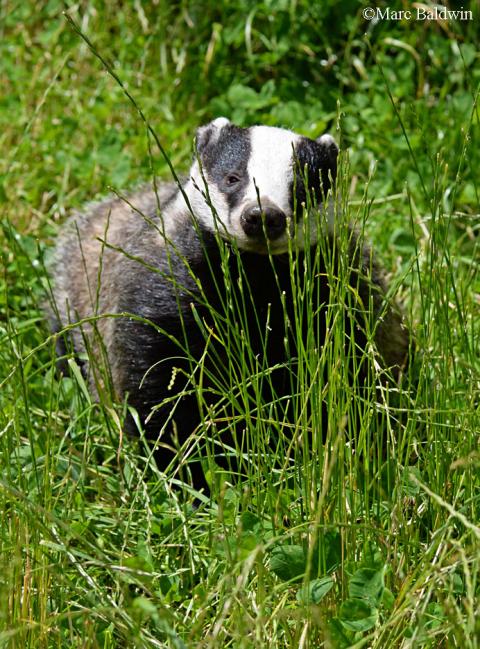
A striking aspect of a badger’s appearance, given their largely nocturnal lifestyle, is their small eyes. In many nocturnal species—particularly owls, rodents and even certain primates, including tarsiers and bush babies—nocturnality is associated with large eyes that gather as much light as possible. In the case of the badger, however, there has been no evolutionary trend towards large eyes, and this likely reflects an important trade-off.
As well as being nocturnal, badgers are primarily fossorial, spending most of their time underground in the sett where no light penetrates; even large eyes are of very limited use in the pitch black. Further, large eyes are potentially a liability for a fossorial mammal, being very prone to damage/irritation from dirt, grit and dust while moving around underground and digging. Instead, badgers have evolved comparatively small eyes that are less susceptible to injury but with a layer or reflective cells just behind the retina called the tapetum lucidum.
Tapetums are common in nocturnal animals and responsible for the eyeshine seen in flash photos, or the reflection of a torch beam or car headlights, which alludes to its function. Light that passes through the retina would ordinarily be lost, absorbed into the tissues of the eye as it is in our eyes. In this case, however, it is reflected back into the badger’s eye where it can be “recycled”, substantially enhancing vision in low light conditions. I’m not aware of any data for badgers, but the tapetum of domestic cats is believed to improve their night vision by 44%. Nonetheless, overall, small eyes, fossorial lifestyle and predominantly nocturnal behaviour suggests that vision probably isn’t a critically important sense.
Most authors have assumed that badgers possess monochromatic vision, that is, they lack the ability to see colours. Certainly, observations that they seem unfazed by torches with red filters implies that their vision is dichromatic (blue-green based) at best. I know of no studies that have tested for colour vision behaviourally (by appraising how badgers respond to different coloured targets) and only one paper that mentions badger retinal composition.
Writing in Zeitschrift für vergleichende Physiologie during 1922, Universität München zoologist Erich Menner presented his observations on the retina of various mammals, including the badger, which he considered similar in structure to that of the red fox, albeit thicker and with smaller, more densely packed nuclei. Of particular interest was Menner’s comment that, despite a detailed review of many preparations, he could only find one type of photoreceptor nucleus in the retina’s outer granular layer - these were rods. Naturally, Menner failing to find any colour-sensing cone cells doesn’t mean badgers don’t have them, but at the very least it implies that, if they are present, they seem vastly outweighed by rods. In other words, this lends support to the idea that badgers have extremely limited colour vision or, more likely, lack it altogether. It seems unlikely there would be a powerful evolutionary driver for colour vision in a mammal with the fossorial and nocturnal lifestyle of the badger.
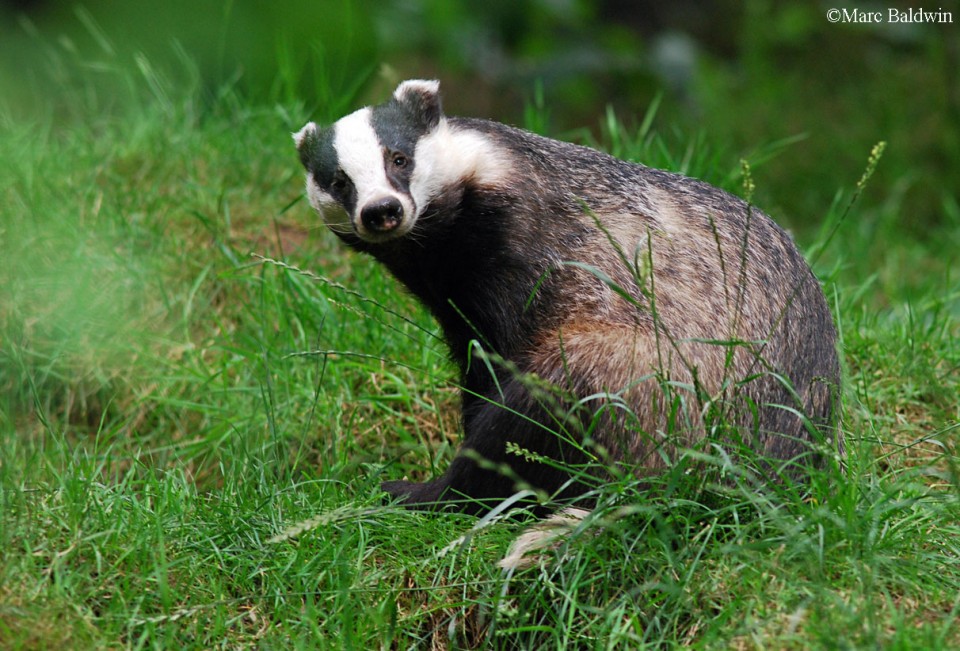
Citing Wickham Malins, writing about a captive badger called “Jess” in his 1974 book Bully and the Badger, Neal and Cheeseman infer a rod-dominated retina from badger behaviour:
“... they have an aversion to strong sunlight and tame animals will retreat to the darkest corner or cover their eyes with their paws under bright conditions.”
Rod cells are much more sensitive to light than cones, allowing them to operate in relatively low light, and a preponderance of these on the retina could explain light hypersensitivity, although the tapetum and pupil control will also influence this.
Regardless of the dominant cell type on the retina, there are many observations from badger watchers to suggest that this species has poor resolving power or, to put it another way, badgers have low-definition vision. Several naturalists have reported badgers coming within centimetres of them, apparently oblivious to their presence, provided they remained down-wind and stayed quiet.
Neal and Cheeseman recounted the experience of naturalist John O’Connor, who watched a badger digging at a sett. When the badger first clocked him, it stared as if surprised. O’Connor made no noise or movement and the badger returned to its excavation. Several times the badger stopped digging and looked in O’Connor’s direction before moving a little closer trying, unsuccessfully, to catch his scent. Eventually, the badger walked right up to him, caught his scent and slowly retreated to the sett; it didn’t re-emerge for the rest of the watch.
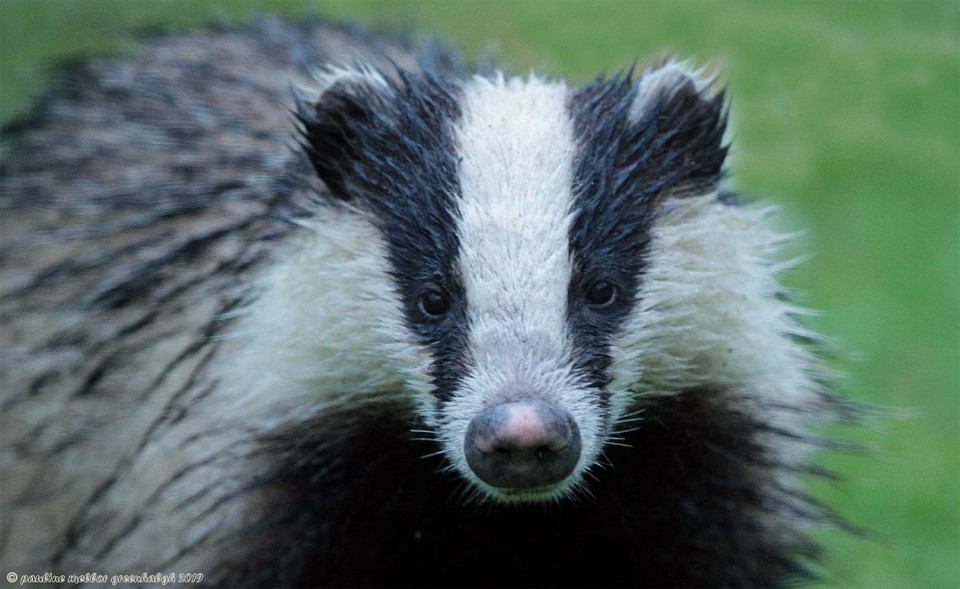
Tim Roper, in his 2010 New Naturalist book, described a badger making several semi-circles of the location in which he was sitting, peering intently at him.
“During all three inspections, it was clear from the badger’s posture that it was looking at me, not trying to scent me.”
Roper considered the badger had spotted a shape that it thought was out of place but couldn’t identify it as human. Had he moved he was certain it would’ve been different, explaining “badgers can discern movement much more readily than they can discern static differences in contrast”. Certainly, any movement does appear to draw their attention. There are, nonetheless, descriptions suggesting that they respond quickly, typically beating a hasty retreat, when observers are silhouetted against the sky, suggesting their eyes detect contrast and basic shapes well. This is further illustrated by a series of experiments carried out on a captive badger clan by Carol Oakley, a student of the venerable carnivore biologist Hans Kruuk.
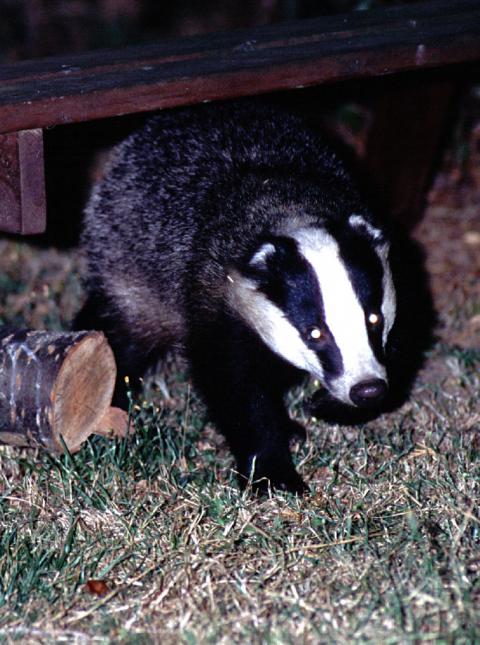
In his 1989 book The Social Badger, Kruuk described Oakley’s small experiment, which involved presenting the badgers with cardboard badger masks with different patterns; one black, one white, one with horizontal black and white stripes, and one with vertical stripes arranged to mimic a badger face. Unfortunately, in the short time the experiment ran responses were only obtained for two boars (males), but it proved interesting nevertheless. Both males attacked the model with the vertical stripes significantly more than the other three. The white mask was never bitten, while the black mask and the one with horizontal stripes were bitten once every 200 and 150 minutes, respectively. The vertically striped mask was bitten once every 45 minutes or so and Oakley observed that the boars also scent-marked more often when this model was presented.
Oakley’s experiments were presumably conducted under good lighting, but even so the results serve to demonstrate that a badger’s eyesight is more than capable of recognising specific contrasting patterns. Indeed, given that a badger’s mask appears to be individual-specific, some biologists have suggested that clan members may be able to recognise one another by their mask pattern. To the best of my knowledge, this has never been studied, although Neal and Cheeseman comment:
“It appears that the eyesight of badgers is good in low intensity light and certainly good enough to recognise the face-mask of their own kind very quickly.”
Ernest Neal, writing in his 1986 The Natural History of Badgers, provides perhaps the most succinct summary of badger vision:
“I believe the importance of eyesight to a badger is to alert the animal in a general way to possible danger so that its other sense organs may analyse the situation in more detail, or confirm a suspicion that has already been aroused.”
Smell
The Badgerland website notes that “It is thought that the badger's sense of smell is 700 to 800 times better than ours!”, but doesn’t qualify or reference the statement. Ernest Neal, in his 1986 book, also considered badgers to possess a very keen sense of smell, although didn’t make any direct comparisons when he wrote: “the sense of smell in badgers is extraordinarily well developed, and is undoubtedly their most important sense”. To the exclusion of the observations made on the badger brain by Neal and Cheeseman (above), however, quantitative evidence for the sensitivity of a badger’s nose is entirely speculative, albeit mostly credible and puissant.
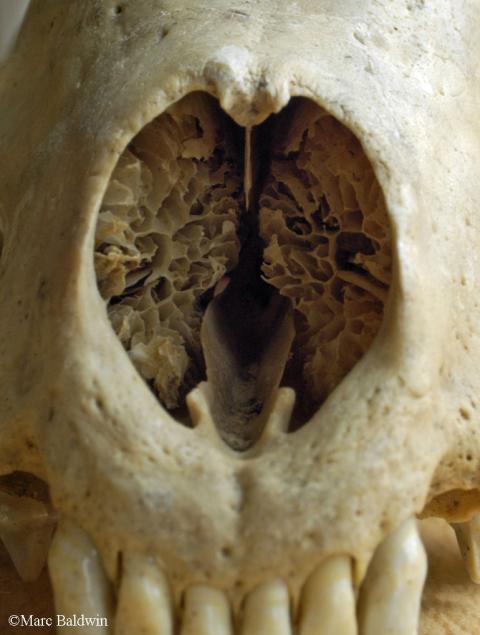
Structurally, the skull of a badger certainly gives the impression of an acute sense of smell. Within the nasal cavity is a network of scroll bones, called turbinals, that serve to increase the surface area of the olfactory epithelium, the layer of tissue responsible for conditioning and “scanning” incoming air for odours. Unfortunately, there don’t appear to be any data on the area of the olfactory epithelium nor the percentage that’s given over to registering odours rather than regulating the temperature and humidity of the inhaled air. If the European badger is similar in its construction to the American badger (Taxidea taxus), we might expect about 75% of its olfactory epithelium to be devoted to odour recognition and an olfactory epithelial area in excess of 310 sq-cm (48 sq-inch, or about the size of a piece of A5 paper), based on CT scan modelling carried out by Blaire Van Valkenburgh and her colleagues. To give this some context, your olfactory epithelium is about 9 sq-cm (1.5 sq-in), about the same size as a camera’s SD card.
Scenting capacity also appears to be linked to structure called the cribriform plate; a thin piece of bone located between the nasal cavity and the brain. The plate is punctuated with tiny holes through which nerves pass and we think that the more holes (or the larger the holes) in the plate, the more nerves the animal has that are dedicated to smell. Similarly, the larger the plate, proportionally, the more neural connections that are likely to be going to the brain. We know from the studies of Deborah Bird at the University of California and others that carnivores, and particularly mustelids, tend to have large cribriform plates relative to their body size, although, to the best of my knowledge, this structure has never been studied in European badgers.
When foraging, badgers typically move with their nose to the ground and make a series of “snuffling” noises as they inhale sharply (presumably to help concentrate faint odours) or exhale violently to blow dust and soil away. In particular, anyone who has had the good fortune to watch badgers emerging from their sett will testify that the first activity is almost invariably to sniff around in all directions. “I have seen scores of badgers come out of setts, but never one that omitted this precaution” wrote Howard Lancum in his short but fascinating book Badgers' Year, published in 1954.
Lancum goes on to describe how residual human scent left outside a sett he was watching caused badgers to retreat to safety. One humid afternoon in May 1952, Lancum pressed the palm of his hand down on a badger path leading from the sett for one minute. Later that same evening, he watched a badger emerge from the sett and follow the path until it reached the spot where his hand had been, at which point:
“There it halted abruptly, took one sniff, shied like a startled horse and incontinently bolted underground. That badger had picked up my scent six-and-a-half hours after the scent had been laid.”
Naturally, the environmental conditions make a difference here, as does the composition of the scent. In 1933, for example, former Master of the Bicester and Warden Hounds, Hubert Budgett, observed that oil from the fingerprints of a man on glass slides remained for six to eight weeks before evaporating, while the scent oil from a rabbit’s foot dissipated within four hours. Nonetheless, Lancum’s observation alludes both to the sensitivity of the badger’s sense of smell and to how odours can be processed very quickly to trigger immediate changes in behaviour.
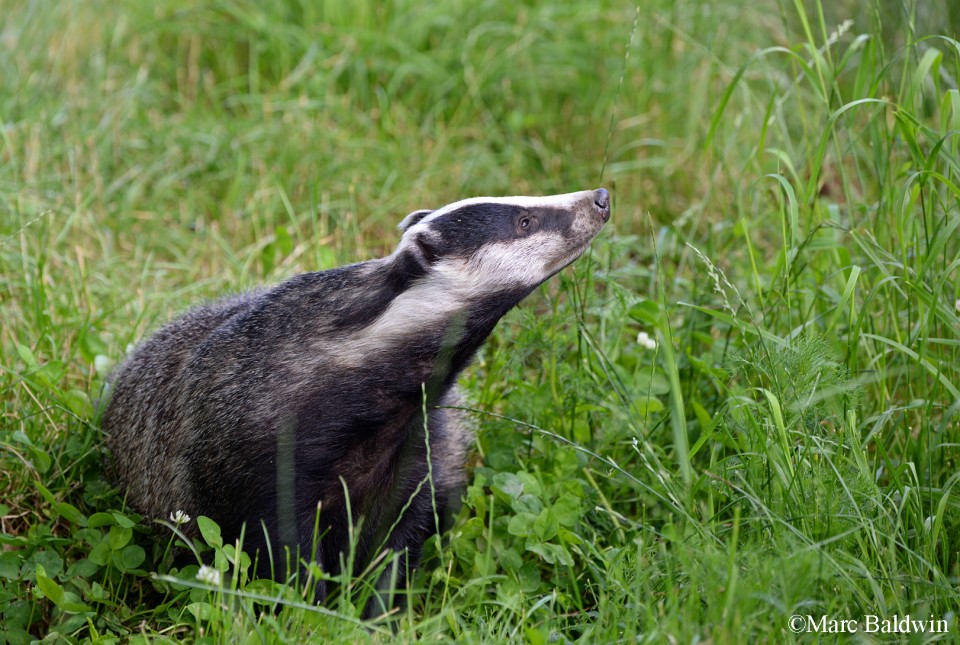
Ernest Neal mentions Lancum’s account in Badgers, although he talks about an experiment having been conducted in the morning a few days before the one quoted above and the badger (a sow with cubs in this case) being spooked 11 hours later, while a boar that emerged at the same time simply took a detour to avoid the scent. As far as I can see, there is no mention of this in Lancum’s book, so presumably it’s based on personal communication between Neal and Lancum. Along similar lines, in the New Forest, Eric Ashby filmed the startled reaction of a badger when it reached the spot at which he’d briefly placed one of his gum boots several hours previously. Additionally, Tim Roper, in his 2010 Badgers, noted that the scent left by people walking around above the sett can delay or even prevent badgers emerging the following night and, if repeated, can cause them to abandon the sett altogether.
Neal in his 1986 book described how badgers continued using the exact same path across a field, even after it had been ploughed and sown with corn, which he infers was accomplished primarily by smell. He also pointed out that badgers can distinguish familiar and unfamiliar human scents and tell the difference between individuals and neighbouring social groups. Subsequently, in their 1996 update of Neal’s text, he and Chris Cheeseman provide anecdotal evidence that badgers can discriminate individual humans by smell, while Hans Kruuk and colleagues were able to train a semi-tame captive animal to respond to scent gland samples taken from individuals from different clans, although it was apparently a slow process. In the study, published in the journal Animal Behaviour in 1984, Kruuk and his team found that the boar could discriminate the scent of one individual from another as well as distinguishing between clan members and “strangers”, explaining:
“... the badger could be trained to distinguish between the subcaudal gland secretions of two badgers regardless of their sex, and at different times of year.”
Similarly, work by Christina Buesching and her colleagues at Oxford University’s Wildlife and Conservation Research Unit has demonstrated that scent plays a vital role in badger society, driving intra-clan stability through allomarking as well as allowing individuals to identify each other and their vital statistics (e.g. sex, age and reproductive state) and recognise neighbouring territories.
Taken together, all these observations point to scent being a pivotal feature of the badger’s world, and it would seem highly likely that their ability to detect and process odours has been well tuned through evolution.
Hearing
Much like their eyes, a badger’s ears are small, unobtrusive structures, characteristic of an animal with a largely fossorial lifestyle. They don’t impede movement along tunnels or collect dirt during moving or digging. In the absence of formal testing, direct observation suggests that badgers have acute hearing. Indeed, they make a variety of calls, from low murmurings to the high-pitched whickering of cubs and staccato warning notes of the sow, implying reasonable hearing over a range of frequencies.
In their 1988 Mammals of the Soviet Union, Vladimir Geptner and co-authors wrote of the badger that “Its hearing is no sharper than that of the human” although they do not qualify this statement. On the Badgerland website, they state: “Their hearing is not as acute as that of a fox, but they are well able to detect quiet sounds; and determine which ones are of concern from those which are not.”
Alan Baldry has captured behaviour on the trailcams in his Suffolk garden suggesting that badgers have sensitive hearing. In one instance badgers stop and listen intently to a noise in the pitch-dark field behind them. Another quite remarkable clip shows a badger foraging along a path when it freezes and listens intently before moving to the edge of the path and pulling up an earthworm that it apparently heard surfacing among the grass.
Ernest Neal, in Natural History of Badgers, reported that individuals he was photographing could hear the recharge whine of his camera flash from some six metres (20 ft.) away. Similarly, while trying to film badgers with Professor Humphrey Hewer in 1954, Neal wrote that they could hear the vibration of the camera’s motor mechanism, despite their attempts to soundproof the housing, and only seemed to ignore it during heavy rain, which presumably masked or attenuated the noise of the camera. That said, the pair had no issues filming badgers at Camberley in 1953 on Coronation night with fireworks being let off all over the place, albeit none closer than 100m (330 ft.).
The observation that the firework display was some way away from the sett is likely to be an important factor in the response. Indeed, Neal suggested badgers get used to background noise, particularly at distance. He also recounted observations from Brigadier Fryer, who spent time watching a sett on MoD land, noting how the badgers paid little attention to distant night manoeuvres, including blank fire and thunder flashes. They stopped and listened, but didn't retreat into the sett, while a slight sudden noise near the sett would alarm them. Badgers also seem to take little notice of thunder and lightning, even at close range that's loud enough to hear clearly on a trailcamera. There is, however, some conflicting evidence in the literature as to the impact of background noise on badgers.
Alongside insouciance towards firework displays and night manoeuvres, Neal mentioned badgers that dug a sett into a railway embankment below the London-Hastings line, apparently ignoring the noise of trains passing overhead, while A.D. Mennear watched badgers at a sett on the flight path into London Heathrow, seemingly oblivious to the air traffic. More recently, by contrast, Roseanna Agnew at the Royal Veterinary College and colleagues found cortisol levels in the hair of badgers living within a kilometre (0.6 miles) of wind turbines to be 264% higher than those living more than 10 km (6 miles) away, which they interpreted as the badgers being physiologically chronically stressed by the turbines. In their paper to the Journal of Wildlife Diseases in 2016, the authors suggest one explanation for this is that the badgers are disturbed by the noise and/or vibrations (infrasound) generated by these units, as humans are known to be.